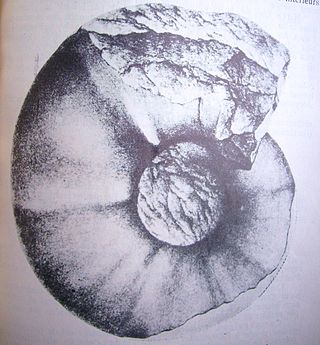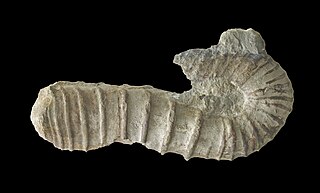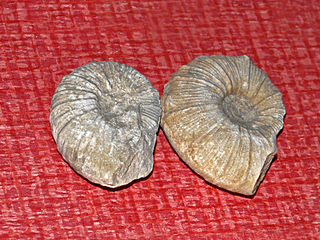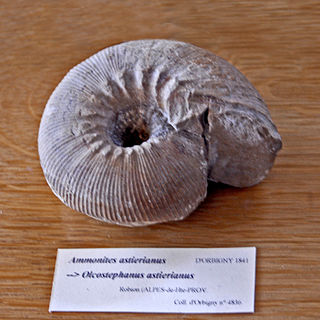
Abrytasites (Abrytusites) is an extinct genus of cephalopods belonging to the Ammonoidea subclass. The genus was named after the ancient Roman town of Abrittus, located near the present Bulgarian city of Razgrad. There are several described species of Abrytasites, including A. thieuloyi, A. julianyi, and A. neumayri. They are inflated, with constrictions, have rather thick ribs springing irregularly, singly or in pairs, from umbilical bullae. Their inner whorls closely resemble types species of Valdedorsella. This animal lived 125–136.4 million years ago during the Hauterivian and the Barremian in Europe and western Africa.

Acrioceras is an extinct genus of cephalopods belonging to the ammonite subclass.

Anahamulina is an extinct ammonoid cephalopod genus from the Lower Cretaceous. Named by Hyatt, 1900.

Astieridiscus is an extinct lower Cretaceous ammonite. Its shell evolute, covered by dense, simple or branching, slightly flexuous ribs. The sides are slightly flattened, the venter rounded. No umbilical or other tubercles except on innermost whorl. Superficially resembles Olcostephanus.

Barremites is an ammonoid cephalopod genus belonging to the family Desmoceratidae, that lived during the Hauterivian and Barremian stages of the Early Cretaceous.

Desmoceratidae is a family belonging to the ammonite superfamily Desmoceratoidea. They are an extinct group of ammonoids, shelled cephalopods related to squid, belemnites, octopuses, and cuttlefish, and more distantly to the nautiloids, that lived between the Lower Cretaceous and Upper Cretaceous.
Heteroceras is a Lower Cretaceous heteromorph ammonite belonging to the ancyloceratoidean family, Heteroceratidae.

Perisphinctoidea, formerly Perisphinctaceae, is a superfamily of Middle Jurassic (Bajocian) to Lower Cretaceous (Barremian) ammonites, commonly with evolute shells with strong ribbing that typically divides about mid flank before crossing the venter.

Desmoceratoidea, formerly Desmocerataceae, is a superfamily of Cretaceous ammonites, generally with round or oval-whorled shells that are mostly smooth or weakly ribbed and rarely tuberculate, but commonly with constrictions. Regarded as monophyletic, the Desmocerataceae are derived from the Phylloceratidae, splitting off in the Early Cretaceous (Valanginian) and persisting to the end of the Maastrichtian.

Barremitinae is a subfamily belonging to the Ammonoidea subclass.

Neocomites is a genus of ammonite from the Lower Cretaceous, Berriasian to Hauterivian, and type genus for the Neocomitidae.

Neocomitidae is a family of Lower Cretaceous ammonitids comprising genera with strongly ribbed evolute to smooth, fairly involute shells.
Pseudohaploceras is a genus of desmosceratid ammonites from the Early Cretaceous; Valanginian to Albian epochs.

Spitidiscus is a genus of ammonites placed in the family Holcodiscidae.

Hamulina is an extinct ammonoid cephalopod genus belonging to the family Hamulinidae. These cephalopod were fast-moving nektonic carnivores. They lived during the Cretaceous period, Barremian age. The type species is Hamulina astieriana.

Hamulinidae is an extinct ammonoid cephalopod family belonging to the order Ammonitida. These cephalopod were fast-moving nektonic carnivores. They lived during the Lower Cretaceous period.

Hemihoplites is an extinct genus of ammonoid cephalopods belonging to the family Hemihoplitidae. These fast-moving nektonic carnivores lived in the Cretaceous period, from Hauterivian age to Barremian age.

Holcodiscus is an extinct ammonite genus placed in the family Holcodiscidae. Species in this genus were fast-moving nektonic carnivores. The type species of the genus is Ammonites caillaudianus.

Pulchelliidae is an extinct ammonoid cephalopod family. It was previously classified as belonging to the superfamily Endemoceratoidea. They lived during the Cretaceous, in the Barremian age.

Olcostephanus is an extinct ammonoid cephalopod genus belonging to the family Olcostephanidae. These fast-moving nektonic carnivores lived during the Cretaceous, from the upper Valanginian to the lower Hauterivian age.


















